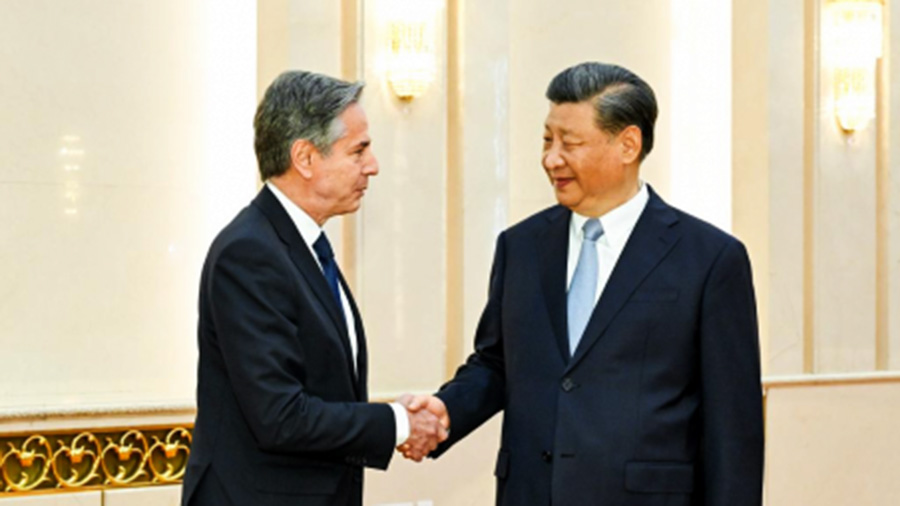BEIJING, (Reuters) – China and the United States agreed yesterday to stabilize their intense rivalry so it does not veer into conflict, but failed to produce any major breakthrough during a rare visit to Beijing by U.S. Secretary of State Antony Blinken.
Chinese President Xi Jinping welcomed “progress” after shaking hands with Blinken at the Great Hall of the People, a grand venue usually reserved for greeting heads of state.
The top U.S. diplomat and Xi both stressed the importance of having a more stable relationship, as any conflict between the world’s two largest economies would create global disruption.
China refused to entertain Washington’s bid to resume military-to-military communication channels, citing U.S. sanctions as the obstacle. The two sides appeared entrenched in their positions over everything from Taiwan to trade, including U.S. actions toward China’s chip industry, human rights and Russia’s war against Ukraine.
U.S. President Joe Biden said later on Monday he thinks relations between the two countries are on the right path, and indicated that progress was made during Blinken’s trip.
“We’re on the right trail here,” Biden said of U.S.-China relations. Asked by reporters during a trip to California whether he felt progress had been made, he replied, “I don’t feel,” he said. “You know it’s been made.”
Biden said of Blinken: “He did a hell of a job.”
At one of the most significant U.S.-China exchanges since Biden took office, it was not clear how the countries would overcome their differences. The sides agreed to continue diplomatic engagement with more visits in the coming weeks and months.
At a news conference concluding his two-day trip to Beijing, the first by a U.S. secretary of state since 2018, Blinken said Washington had achieved its objectives for the trip, including raising concerns directly, trying to set up channels for dialogue and exploring areas of cooperation. The trip was postponed in February after a suspected Chinese spy balloon flew through U.S. airspace.
But he said progress was not straightforward.
“The relationship was at a point of instability, and both sides recognized the need to work to stabilize it,” Blinken said before leaving China.
“But progress is hard. It takes time. And it’s not the product of one visit, one trip, one conversation. My hope and expectation is: we will have better communications, better engagement going forward.”
U.S. officials had been playing down the prospect of a major breakthrough, but hoped Blinken’s visit would pave the way for more bilateral meetings, including possible trips by Treasury Secretary Janet Yellen and Commerce Secretary Gina Raimondo.
It had been hoped that it would even pave the way for a summit between Xi and Biden later in the year.
Biden and Xi last met on the sidelines of the G20 summit in Indonesia in November, pledging more frequent communication, although ties have since deteriorated.
“The two sides have also made progress and reached the agreement on some specific issues. This is very good,” Xi told Blinken on Monday across a long table adorned with pink flowers.
Blinken responded by saying the two countries have a responsibility to manage their relationship.
His meetings in Beijing, including talks with China’s top diplomat Wang Yi and foreign minister Qin Gang, had been “candid and constructive,” Blinken added.
It was not clear from Xi’s remarks what progress he was referring to, although he told Blinken that China “hopes to see a sound and steady China-U.S. relationship” and believes that the countries “can overcome various difficulties,” according to a Chinese readout of the talks.
Xi also urged Washington not to “hurt China’s legitimate rights and interests,” a signal of potential flashpoints such as Taiwan, the democratic island Beijing claims as its own.
Blinken said he made clear the United States needs much greater cooperation from China on stemming the flow of fentanyl and the sides agreed to set up a working group on the matter.
The lack of open communication channels between the two countries has prompted international jitters, and Beijing’s reluctance to engage in regular military-to-military talks with Washington has alarmed China’s neighbors.
Speaking to reporters after the talks, senior foreign ministry official Yang Tao said U.S. sanctions were blocking progress on improving military-to-military communications.
Chinese defense minister Li Shangfu has been sanctioned since 2018 over the purchase of combat aircraft and equipment from Russia’s main arms exporter, Rosoboronexport.
Asked what specific progress the two sides had made, Yang said they had agreed to prevent a downward spiral in relations. The official added that Chinese foreign minister Qin had accepted Blinken’s request to visit the United States.
Xi’s comments, and the diplomatic choreography of the visit, appeared to signal a will to make progress, analysts said.
“China’s messaging has been pretty positive,” said Wu Xinbo, a professor and director at the Center for American Studies at Fudan University in Shanghai.
“China showed that it still hopes to work with the U.S. to stabilize and improve relations. I think that while China is not optimistic about Sino-U.S. relations, it has not given up hope either.”
Beijing’s tone on Taiwan was particularly pointed throughout Blinken’s visit.
“China has no room for compromise or concessions,” said Wang, according to the Chinese readout.
The United States has long stuck to a policy of “strategic ambiguity” over whether it would respond militarily to an attack on Taiwan, which Beijing has refused to rule out.









